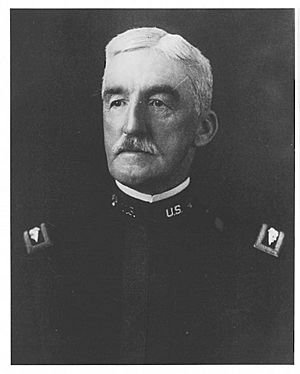Rogers Birnie facts for kids
Quick facts for kids
Rogers Birnie
|
|
|---|---|
 |
|
| Born | 5 April 1851 Taneytown, Maryland |
| Died | 25 September 1939 (aged 88) Washington, D.C. |
| Allegiance | United States |
| Service/ |
|
| Years of service | 1872–1915 |
| Rank | |
| Battles/wars | Spanish–American War |
| Relations | Ernest Graves Sr. (son-in-law) Ernest Graves Jr. (grandson) |
Rogers Birnie (born April 5, 1851 – died September 25, 1939) was an officer in the United States Army. He was also a famous explorer who helped map and study places like Death Valley.
Contents
Early Life and Education
Rogers Birnie was born in Taneytown, Maryland. He grew up in Gettysburg, Pennsylvania. During the American Civil War, he could hear the sounds of the Battle of Gettysburg from his home.
He was a very smart student. In 1872, he graduated at the top of his class from West Point. After graduating, he joined the Infantry branch of the Army. His first assignment was at Fort Douglas, near Salt Lake City.
Exploring the American West
Joining the Wheeler Survey
In 1874, Birnie joined the Wheeler Survey. This was a team that explored and mapped parts of the western United States. During this survey, he made an important discovery. He found ancient ruins built by the Ancestral Puebloans. These ruins later became a UNESCO World Heritage Site. This means they are protected as a special place for everyone.
Adventures in Death Valley
In 1875, Birnie led his own expedition. He traveled from Los Angeles, over the San Gabriel Mountains, and through the Mojave Desert. During this trip, he became the first scientist to explore Death Valley. He studied its unique features and recorded important information. After exploring Death Valley, he even climbed Mount Whitney, which is the tallest mountain in the lower 48 states.
For the next three years, Birnie continued to lead survey teams. He explored and mapped areas in Nevada, Idaho, and New Mexico. His work helped create better maps of the American West.
Co-founding National Geographic
Birnie was also one of the people who helped start the National Geographic Society in 1888. This famous organization is known for its magazines, TV shows, and research about geography and exploration. Birnie served as the first manager on their board of directors.
Military Career and Later Years
In 1878, Birnie moved to the Ordnance Corps in the Army. This group deals with weapons and military equipment. He worked at important places like the West Point Foundry and Springfield Arsenal. He helped bring in new, stronger steel guns for protecting the coasts of the United States.
During the Spanish–American War, Birnie served in Cuba. He was a Lieutenant Colonel. After the war, he was in charge of taking over weapons and forts around Havana from the Spanish army.
Birnie retired from the Army in 1915. Even after retiring, he continued to work. During World War I, he worked for a company that made arms and fuses. Rogers Birnie passed away in Washington, D.C., on September 25, 1939.

